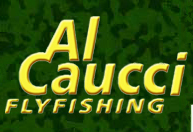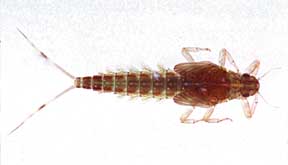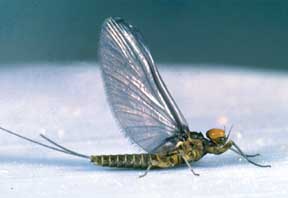
![]()
Trips
Montana
Missouri
SW
Montana
Clark Fork & Bitterroot
Bahamas
Andros Island
Upper Delaware
Other Destinations
Alaska
New Zealand
Argentina
Chile
![]()
News
![]()
River Updates
Hatch
Chart
![]()
Campground
![]()
Tips
Articles
ACFF
Photo Gallery
![]()
Al Caucci's Biography
Testimonials
![]()
Contact Us
Home
![]()
Your fishing logs at Ecolure
![]()
Friends of the
Upper
Delaware
![]()
1250 Winterdale Road
Starlight, PA, 18461
Phone : 1 ( 570 ) 635 - 5897
email : alcaucci@hancock.net
 |
|||||
|
Everything You've Always Wanted To Know About Blue-Winged Olives By Al Caucci
Although there are good hatches of large Isonychia (sizes 10 & 12), medium-sized Stenonema (sizes 14 & 16) and smaller size 16 Baetis mayflies in the late summer and fall, the staple for trout during this period are the tiny blue-winged olive Pseudocloeon (sizes 22 to 28) and Tricorythodes (sizes 26 to 28). The tiny Trico's and Pseudo's hatch in unbelievable numbers, and are a constant supply of food for trout on the rich spring creeks, prolific tailwaters, and quiet stretches of rich freestone rivers. I'll concentrate on the Pseudo's in this column, and leave the Trico's for another issue. The tiny blue-winged olive duns of Pseudo-cloeon are easy to recognize in spite of their small sizes. They have no hind wings and only two tails (Trico's have three tails) in the dun and spinner stages. The wings are plain with no markings, and range from pale to medium gray. The body colors range from medium olive to dark brownish olive, according to the species. Pseudo's are multi-brooded-most species hatching two or three times during the course of the season. Anglers can expect to encounter a hatch during cloudy days from June through mid September. From mid September to November, they will also hatch on sunny days. The nymphs hatch in a variety of water types and are slow emergers. They are most prevalent in the alkaline spring creeks and high pH enriched tailwater rivers. This sluggish hatching behavior, plus their prolific numbers and long hatching periods, make them a favorite with trout-and even very large trout. The best water temperature range for these hatches is between 48 and 55 degrees F. Owing to their difficulty during the emergence process, many are half drowned or crippled on the surface during the hatch. This situation is ideal for using dun and emerger patterns with a low wing silhouette. Color is less of a problem with these diminutive insects, but size and silhouette are absolutely critical. Pseudo's usually hatch in great numbers, causing fierce selectivity. A size 24 versus a size 26, or a low-wing silhouette versus an upright wing, will often mean the difference between a take or a refusal. Always carry the complete size range of patterns for this hatch, and catch a natural to confirm the size. It's amazing how different an imitation can look when compared to the real insect. You'll also be astonished to discover how large the body diameter of your imitation is when compared to the slender bodies of the delicate duns. When tying or purchasing an imitation for a size 22 or smaller, you don't need dubbing-just a wound silk body to keep the body slender, and a wisp of CDC or fine deerhair for the wing. Fine tippets of 6x and 7x are a necessity when using tiny flies, as is a drag free float. The slack-reach cast is mandatory to eliminate micro drag when fishing this hatch. The Pseudo spinner falls seldom occur when you expect them-they just happen. And if you are not paying close attention to the water surface, you won't see these insects floating by, because they have no silhouette to mark their presence. Many times spinners will appear during a hatch of duns, so pay close attention to the water, especially if your pattern is being ignored or refused. Another way to resolve the spinner versus dun dilemma is the riseform. Although the rises to the duns are subtle and sip like, when the trout rise to the spinners, the riseform is barely perceptible. These very faint sips indicate they are sipping spinners. Like the dun, the spinner imitation need not be complicated-just make sure the size and silhouette are correctly matched.
It is impractical to fish a Pseudo nymph imitation effectively on the bottom, due to the size and the quick and evasive manner of the natural. Pseudo nymphs are, however, very sluggish and clumsy during actual emergence, and a tiny nymph that floats in or on the surface film can be quite effective right through the hatch, even though the water may be covered with floating duns. This is mainly due to the nymph's slow, drifting ascent, and the difficulty they experience escaping their nymphal shucks. A size 22, 24 or 26 nymph is almost impossible to see on the water, so at times I tie my nymph imitation on a dropper, which is attached to a size 16 or 18 (or even a size 24) Comparadun. The Pseudocloeons are my favorite hatch to fish, particularly from late September until the end of October, when they hatch daily in unbelievable numbers on my home rivers on the Upper Delaware. One of the ultimate accomplishments in fly fishing is to hook, play (pray), land and release a wild 16" to 18" brown or rainbow on a size 26 fly attached to a 6x or 7x tippet. Go do it-it will be one of the high points of your season!
|
|||||

